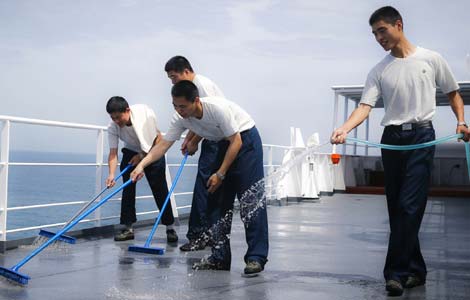Open horizon for China's pilots
Updated: 2013-09-17 07:24
By Wang Wen (China Daily)
|
|||||||||||
|
Pilots in a Boeing 787 simulator in Singapore. Chinese airlines can also train new pilots for 787 aircraft in Shanghai, because the same simulator has been operating in Shanghai since June 2012. Provided to China Daily |
China will lead Asia-Pacific demand for new commercial airline pilots and maintenance technicians to support the country's fast-growing fleet over the next two decades.
The nation will need 77,400 new pilots and 93,900 technicians through 2032, Boeing said in its latest pilot and technician outlook, which was released on Monday.
"There is a very real, urgent demand for competent aviation personnel globally, and the Asia-Pacific region is particularly impacted," said Bob Bellitto, global sales director, Boeing Flight Services. Chinese carriers' fast-expanding capacity will drive this demand.
China will take delivery of 5,580 aircraft, and its fleet will triple to 6,450 planes over the next 20 years, according to the United States-based aircraft manufacturer.
But providing staff for the Chinese civil aviation industry will be a challenge, experts said.
As of Dec 31, there were 31,381 licensed pilots, up 3,574 from a year earlier, according to the Civil Aviation Administration of China.
The number of pilots in China keeps growing but can't keep up with demand, said Zou Jianjun, a professor at the Civil Aviation Management Institute of China.
"Chinese civil aviation had a shortage of more than 10,000 pilots in 2012 and the number has increased this year," Zou said. "Captains, especially those flying wide-body aircraft, are the ones in demand, not ordinary pilots," he added.
Long-haul international traffic to and from China is forecast to grow at an annual rate of 7.2 percent, which will result in demand for an additional 1,440 new wide-body aircraft by 2032, according to Boeing.
More wide-body aircraft are being used by Chinese airlines on international and domestic main routes, Zou said, which means carriers need more experienced captains and pilots.
Usually, an airline needs eight to 10 pilots per aircraft. It takes two to three years to train an experienced pilot, and achieving the rank of captain takes five to eight years.
Because of the shortage, some pilots said they have to work more.
"I often fly more than 90 hours monthly, which is near the authority's upper limit of 100 hours," said a pilot with three years of flying experience, who declined to be identified.
Some domestic airlines recruit foreign captains to relieve the problem, but that's not a long-term solution, Zou said.
The opening of low-altitude airspace for general aviation will be an opportunity for pilot training in China, since it will be much easier to conduct training flights, he said.
Because it is difficult to get flying hours in China, some Chinese airlines establish flight training centers overseas. "The situation will change if low-altitude airspace is opened," Zou said.
Technicians are in short supply, Zou said. He didn't provide a specific number, but the shortage is even worse than for pilots, some industry insiders said. The ratio of technicians to planes in China has kept falling as the fleet expands.
A technician from a domestic carrier said he used to work alone, covering six planes in eight hours. "It's my record," he said. "It proves we need more hands."
wangwen@chinadaily.com.cn
Today's Top News
List of approved GM food clarified
ID checks for express deliveries in Guangdong
Govt to expand elderly care
University asks freshmen to sign suicide disclaimer
Tibet gears up for new climbing season
Media asked to promote Sino-Indian ties
Shots fired at Washington Navy Yard
Minimum growth rate set at 7%
Hot Topics
Lunar probe , China growth forecasts, Emission rules get tougher, China seen through 'colored lens', International board,
Editor's Picks

|

|

|

|

|

|






